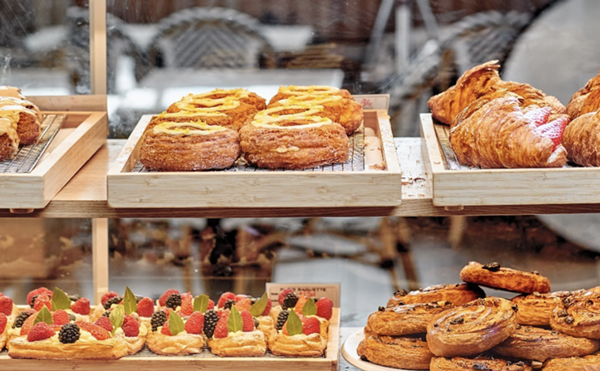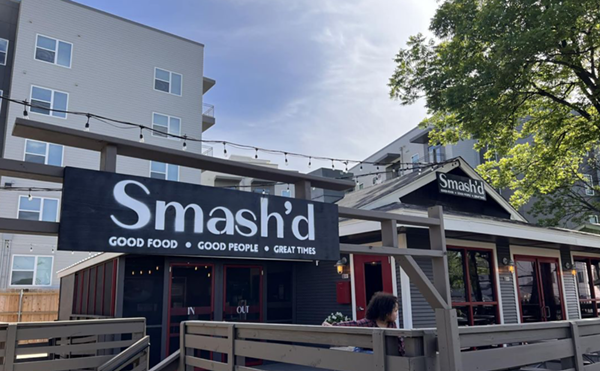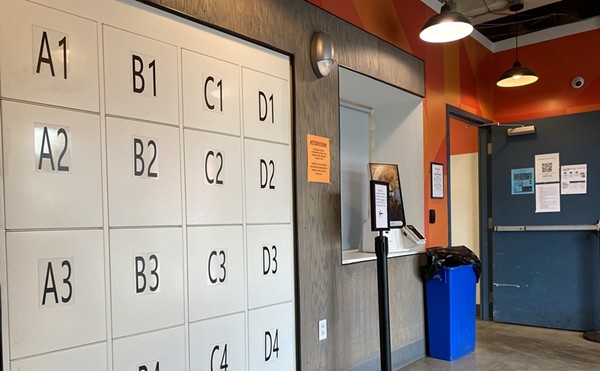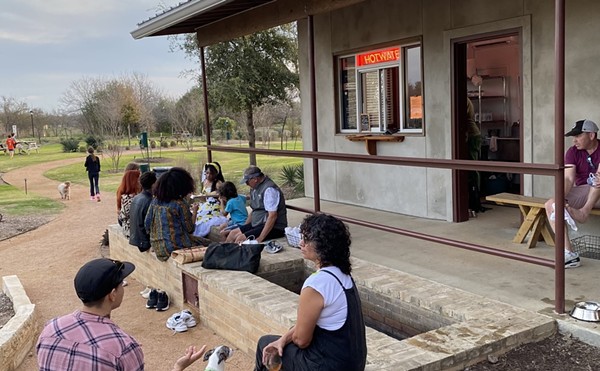A golden glow often surrounds early, life-forming experiences, so you may feel free to lower the luster level of what’s to follow. This particular memory has to do with traveling by bus in the highlands of Colombia during a two-year stint in the Peace Corps. At every wide spot in the road, it seemed, campesinas would come clamoring up to the bus windows with baskets of fresh arepas, gordita-shaped but made from unslaked cornmeal and often stuffed with a white, homemade cheese. They were cheap, they were good, and they were symbolic of the whole experience. (These same women also sold stuffed chicken necks, a delicacy that doesn’t rank quite as high on the nostalgia meter.)
It was thus with a certain air of expectation that I first set foot in Fonda Latina, a new restaurant celebrating Colombian and, nominally, Venezuelan food. Bring on the arepas, I thought. And they did — the first stuffed with a shredded chicken mixture that was much fancier than any of the bus-side offerings of my youth. It was good, especially after adding liberal lashings of ají, the vinegary Colombian equivalent of our familiar salsa de mesa, but it didn’t ring bells. Nor did the arepa with morcilla, unpretentiously presented as a blood sausage alongside a corn cake. The sausage was fine, but the arepa lacked both the literal and historic weight of its Proustian counterpart. Maybe it’s time to adjust memories.
Much of the menu at the Fonda does continue to evoke months in the Colombian countryside, however, and the sopa de plátano, one day’s special, was just such a dish. A simple chicken broth studded with potato and chunks of starchy, under-ripe plantain gets a garnish of chopped cilantro — and that’s it. The flavors are simple, immediate, and evocative.
A humble simplicity informs even the more elaborate plates, such as the
bandeja paisa, a combination platter featuring steak, rice, fried ripe plantain, chicharrón, pork sausage, red beans, and, yes, an arepa. Oh, and if they remember, a fried egg to top the rice or the steak, as you prefer. The thin steak is OK but no great shakes, and the thick pork skin seemed a little tired, but the sausage was flavorful, and the combination was just as you might expect to find it in a slightly more prosperous rural home — right after market day when the inevitably tough meat is still fresh. (Our cook used to hang slabs of it over the smoky wood stove to “cure” in lieu of refrigeration; it was eggs and sardines, plus the occasional chewy chicken, after that.)
Yet another memory was triggered by Fonda Latina’s agua de panela caliente con queso. Panela is a crude, brown-sugar product, sometimes made in the countryside from the juice of sugar cane crushed in a donkey- or ox-powered trapiche. (Another byproduct of that juice was guarapo, a burly brew often fermented in a hollowed-out log. The ritual was this: you brushed the flies off the surface, dipped in a gourd, and tried to look grateful for the refreshment — hoping against hope you wouldn’t be pressed to have a second round.) Little more than the piloncillo-like sugar dissolved in hot water — sometimes with a little lemon added — this version was presented in a bowl with slabs of panela-like (same word, no obvious connection) white cheese. It may be an acquired taste, but we’re talking cultural experiences here.
Those experiences tended to vary considerably in Colombia, depending upon altitude or proximity to the coast. My time was spent mostly in the high and cold alteplano, so I missed out on artifacts such as the cowhide and leather bags that were carried by men in tierra caliente; one adorns a column at the restaurant. I missed out on the most colorful of the rural buses, clay versions of which adorn another wall.
And I had to get my banana-leaf-wrapped Colombian tamales on visits to other volunteers and cities. The stuffings also varied considerably, as I recall, sometimes including hard-boiled eggs, olives, and even raisins. Fonda’s rendition makes use of chicken, carrot, chick peas, and chicharrón in a cornmeal-like matrix. It’s quite yellow in color, probably the result of a “salsita color” compounded of achiote, and very good. Plan to share.
The meat-stuffed empanadas, on the other hand, are great one-person starters and are to be wrapped in an arepa-like dough.
Another great classic — one that appears all over the country — is bistek a caballo, a plate that tends to confound non-native speakers of Castellano, as the Colombians are fond of calling their language. No, it does not translate as steak on horseback — “A caballo” means with a fried egg on top. Don’t ask; I have no idea.
Though I spent time living in Bogotá as well, I don’t have the same feeling for what may be Colombia’s national dish — at least it’s directly tied to the capital by its name, ajiaco Bogotano. This is essentially a thick and hearty chicken stew utilizing three different kinds of potatoes, seasoned with a grassy herb called guascas, and topped with capers, avocado, and drizzles of fresh cream. Fonda Latina uses at least two potatoes; the third may have disintegrated as it’s supposed to do. And I was offered cream, capers, avocado, and rice on the side. Though it wasn’t mentioned in any of the recipes I found, there was also another meaty ingredient, likely a smoked ham hock. Consider it a pilon and a reminder that cuisine evolves, even when it’s emblematic of an entire country. •
Fonda Latina Restaurante
6714 San Pedro Ave.
(210) 824-2544
The Skinny
Fonda Latina captures the authenticity of Colombian cooking. Bathrooms not handicap accessible.
Don't Miss
Banana-leaf-wrapped tamales and the arepas con pollo with the signature ají.
Hours
11am-10pm • Tue- Sat,
10am-3pm • Sun
Prices
$7.50-$12.50 • Entrees

















